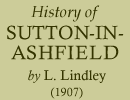< Previous | Contents | Next >
A FAMOUS HOAX.
An account may be given of a famous hoax, or fraud, practiced on the Sutton people in the year 1866, by a man who called himself Van Quillan. This man came to Sutton and brought two old women with him from Sheffield, and said they were heirs to the enormous estate of the late William Jennings, of Birmingham, who died intestate, and whose wealth, with all its accumulations, was lodged, as he said, in the Bank of England, only awaiting the right heir. He told the people that he had made out a satisfactory pedigree, proving these old women to be the heirs at law, and all that was required was a little ready money to enable them to substantiate their claim. Mr. Van Quillan invited several people to supper, and told them that for every pound laid down these old ladies would give £500 on the receipt of their fortune; and in a very short time he succeeded in obtaining something like £300, and decamped with it, leaving behind him "bonds," signed and stamped, which is all the unfortunate holders have to show for their money. The two old ladies had several eligible offers of marriage, which, however, did not lead to matrimony; and after sojourning a considerable time in Sutton, supported by Mr. Van Quillan, they returned to Sheffield, whence they came. Several of the tradesmen and persons of the greatest respectability were taken in, and subscribed various sums from £20 downwards, to become possessors of these bonds.
KING HENRY II. AND THE MILLER.
Closely connected with the history of the parish of Sutton is the tradition of King Henry II. and the Miller. Midway between Sutton and Mansfield is the Reservoir which was constructed by a former Duke of Portland, and which in a time of bad trade afforded employment to hundreds of distressed stockingers, and which irrigates the Duke's meadows. This Reservoir, consisting of about 80 acres, formerly the site of a farm on which a Mr. Samuel Hibbert was born one 29th of February, thus having but one birthday in four years,—is partly in Sutton and partly in Mansfield parish, and at the north-east of it stands the King's Mill, which, at one time, formed part of the possessions of the Crown. It is said that in the days of King Henry II. this Mill was occupied by John Cockle, who resided here with his son and his daughter Margery. One day in hunting the King was separated from his retinue, and found his way towards dusk to the Mill, and requested the mistress of the house to give him food and a night's lodging. Upon remarking that he looked like a clean, decent man, she gave him some supper, and arranged that he should sleep with her son Dick. In the morning she gave him some breakfast, and "Carrotty Margery" waited upon his Majesty; and whilst engaged on the meal a number of courtiers arrived, asking if anything had been seen or heard of the missing King, in search of whom they had been engaged all the night. The King then declared himself, much to the amazement of Mistress Cockle, who went on her knees to beg pardon for the familiarity with which she had treated him, and above all for putting him to sleep with her son. But the King graciously thanked her for her kindness and hospitality, knighted her husband on the spot, and thus made her "My Lady;" and the story goes on to say that the despotic Monarch insisted on one of his lords taking "Carrotty Margery" to wife, and finding a wife for his quondam bedfellow amongst the ladies of the court.
THE LUDDITES.
The Luddites, from Derby and Nottingham, paid a visit to the town of Sutton in the winter of 1811. Their object and intention were to destroy all the stocking frames in the country that made more than one stocking at a time. Their numbers exceeded 1,000, and they were armed with guns, bludgeons, and hedgestakes. They commenced their destructive work at Smedley's End, and succeeded in either burning or breaking up 200 frames. It happened that about six soldiers were passing through the neighbourhood at the time, escorting a prisoner, and these, together with about 20 yeomanry, under the orders of the county magistrates, arrived in Sutton during the night and quickly dispersed the mob, who ran away on the first charge.
RECREATION GROUNDS.
Adjoining the National Schools, is a recreation ground of about four acres, which was let to the Sutton Urban District Council by the Duke of Portland in 1860 or thereabouts, at a nominal rental, for the use of the parishioners. It is walled in, and during the summer is greatly frequented by the youths of the parish for cricket, and in winter for football, and other games.
A second recreation ground is situated in Hardwick Lane, the area being three acres. It is rented by the Council from the Unwin family for an annual payment of £9. It was opened by the late Mr. W. M. Oates, J.P., the then agent of the Unwin family, on the occasion of the celebration of the late Queen Victoria's Diamond Jubilee in June, 1897.
A third recreation ground for the use of the inhabitants at Enstfield Side is an area of about two acres, known as the "Hillocks," being the property of the Urban District Council. It was formerly a quarry, and was filled in by the Council in 1896.
THE NATIONAL SCHOOLS.
Close to the Vicarage are the National Schools, built 1845, of stone, accommodation then being provided for upwards of 200 children. In 1867 a classroom was added, followed by an infants' room in 1882, the accommodation now being for over 400 children. These schools have been in a high state of efficiency for the past 10 years, and have received admirable reports from the different Government Inspectors by whom they have been visited. The headmaster is Mr G. W. Owen, a native of Portsmouth, who has held the appointment since September, 1871. He succeeded Mr. B. B. Slater, who followed Mr. H. Columbine, a native of Sutton. Miss Salter is headmistress of the Infants' School. The correspondent is Mr. C. H. Kitchen, of Red House, Eastfield Side.
FREE LIBRARY.
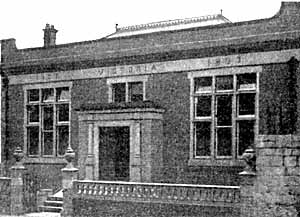 |
This public building is situated in Forest Street, in close proximity to the Midland Railway Town Station. It stands well elevated above the road, and is built of brick and terra cotta, in the Elizabethan style of architecture. The entrance is 9ft 6ins wide, giving access to a ladies' room 17ft. by 14ft. on the left, and a lending library 26ft. by 17ft. wide on the right. The dimensions of the reading room are 35ft, long by 25ft 6ins wide. Lavatories and stores are provided. All the rooms are 14ft. high, and well lighted and ventilated, the heating being done by hot water and open fires. The floors are of wooden blocks. The building was erected in commemoration of the late Queen Victoria's Diamond Jubilee in 1897. The site was given by His Grace the Duke of Portland—a generous benefactor to the town—who also headed the subscription list. It was opened by the Duchess of Portland early in May, 1898. The cost of between £2,000 and £3,000 was defrayed by public subscription. The Chairman of the Sutton Urban District Council (Mr. J. C. Sampson, J.P.). initiated the scheme, and the joint secretaries were Messrs. C. H. Kitchen and J D. Fidler. The architect was Mr. J. P. Adlington, of Sutton. The circulating library contains between 1,100 and 1.200 volumes, including works by the following well-known authors:—Charles Dickens, Sir Walter Scott George Elliott, Charles Kingslcy, Mrs. Wood, W. M. Thackeray, Mrs O. F. Walton. Charles Reade. E B. Browning. Tennyson, Milton, Shakespeare, Byron, Wordsworth. Longfellow. R. Browning W. II. G. Kingston, Burns Mrs. H. B. Stowe, Longfellow, Captain Marryat, Shelley. &c. Gifts of very valuable works have been made to the library by Mr. G G. Bonser, of Sutton, and others. The librarian is Mr C. G. Burton, whose salary is £52 per annum The institution is maintained by a 1d. rate. The chairman of the Library Committee is elected annually.
CONSERVATIVE AND UNIONIST WORKING MEN'S CLUB, LTD.
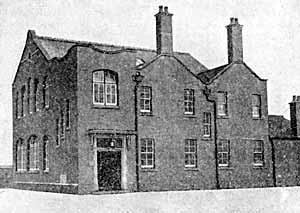 |
These premises are situated in Forest Street, adjacent the King's Theatre. Part of the site was given by the Unwin-Heathcote Family. The building, which stands about 20 yards back from the main street, was built by Mr. J. Greenwood, of Mansfield, from designs by Mr. F. P. Cook, of Mansfield. It is an attractive structure, being built of brick, with Ibstock facings and stone dressings. All the material is local. On the ground floor are an entrance hall; a smoking and reading room about 14ft. square, and a billiard room containing two full-sized billiard tables, with lounge, leading out of which is the bar. Upstairs, is the Portland Assembly Room, measuring 42ft. by 28ft., and capable of seating about 250 people, which can be divided when required by a screen arrangement. On the same floor is a committee room, and accommodation is also protided for the caretaker. The foundation stone was laid by Colonel A. U. Heathcote, Esq., of Shephalbury, on July 12th, 1904, and the premises were opened on January 21st, 1906, by the Duke of Portland, who, on the occasion, was presented by the architect with a gold key bearing the inscription:—"Presented to His Grace the Duke of Portland, K.G., at the opening of the Sutton-in-Ashfield Conservative and Unionist Working-Men's Club, January 21st, 1905." The Club is in the hands of a limited liability company, registered with a capital of £5,000. The cost of the building was £2,200, inclusive of the furniture. The premises are used, not only as a centre for recreation and amusement, but for educational purposes as well. The secretarial duties in connection with the building scheme were performed by Mr. C. H. Kitchen, and the chairman of the committee was Mr. A. H. Bonser, J.P. The caretaker is Col-Sergeant Hubert Jones, of Nottingham, and secretary, Mr. H. S. Shacklock, solicitor, of Sutton. The number of members oh the books is 300.
THE LAWN PLEASURE GROUND.
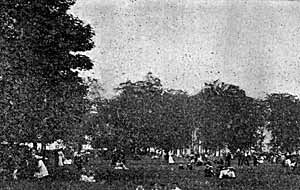 |
The Lawn Pleasure Ground, which is the most picturesque place in the parish, comprises an area of about 20 acres. It was leased for 21 years by the Sutton Urban District Council, for the benefit of the inhabitants, from the representatives of the Unwin family, through their agent (Mr. F. P. Cook), at Michaelmas, 1903.
A caretaker (Mr. Hy. Parnell) is employed at a weekly salary of £1 1s., and £50 per annum is paid in rent, the entire cost of maintenance being met out of the general district rate of the parish. It is a much favoured spot for the holding of al fresco gatherings.
THE UNWIN FAMILY.
The increase of population in Sutton at the close of the last and commencement of the present century was brought about in a great degree by the connection of the parish with the Unwin family, who still own much property here. Over a hundred and fifty years ago Samuel Unwin settled at Sutton, and had two sons—Samuel and William—being previously connected with the place by family ties. It is said that he came from Hackney. Both were fortunate in marrying heiresses, the elder having secured the affections and wealth of Miss Heathcote, and the younger those of Miss Craddock, of Walsall, in 1767. Samuel, the elder, built Sutton Hall, and planted the grounds on "The Lawn;" whilst William, the younger, resided at Mansfield, in Stockwell Gate. His daughter married Mr. Francis Brodhurst, who built Gilcroft House. They built the factory at Eastfield Side, adjoining the Mill Dam, at a cost, it is said, of £6,000, for the manufacture of nankeens and ginghams, which were famous for the excellence of their quality all the country round. They also built large mills at Tansley, near Matlock. They procured from London and elsewhere a great number of young people as apprentices. William died young, and was the first to be buried in the large vault adjoining the Chancel, which was bricked up in 1869. in the presence of the Vicar (Rev. C. Bellairs). the Churchwardens (Mr. John Knowles Daubeny, Mr. George White, and Mr. Thos. Robinson, of Hucknall), and of Mr. W. Oates, who for many years had been the respected agent of the Unwin family, and who died September 9th, 1879, at the age of 76 years. The latter wassucceeded by his son, Mr. W. M. Oates, who died September 30th, 1902, and the position is now held by Mr. F. P. Cook, surveyor, of Mansfield Woodhouse. The other bodies deposited in the vault are those of William Unwin's widow, who died in 1816 from the effects, it is said, of fear, produced by the earthquake which at that period visited the neighbourhood—of Samuel Unwin, who died at Sutton Hall, suddenly and intestate, in 1800—of his widow, who afterwards married Dr. Hulme, of Ball Hayes, Staffordshire; three daughters and a grandson of William Unwin, and lastly, of Mr. Edward Unwin, an active magistrate for the county, son of Samuel Unwin, who died at the Sutton Works, unmarried, A.D. 1841. The grandson of Samuel Unwin assumed the name of his grandmother Heathcote. and built a handsome residence on his Hertfordshire estate, called Shephalbury. The Unwins are closely connected with the Wigrams and Heygates. They ceased to reside at Sutton in 1825, and the old Hall, which, for many years, was occupied by a Mr. and Mrs. Woolley, afterwards stood in ruins until at length not a remnant of the building remained. Old associations, however, were revived when, in 1884, the Unwins built the present residence for their then agent (Mr. W. M. Oates) on the site of the old Hall. It is now occupied by Mr. J. D. Fidler, Solicitor, and Clerk to the Sutton Urban District Council, who has been resident there since January 21st 1903, shortly after the death of Mr. Oates.
SUTTON'S FIRST MILL, OR FACTORY.
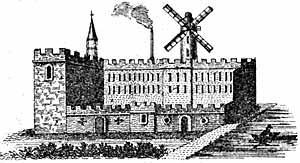
This will, no doubt, he found to be one of the most interesting illustrations in this volume, inasmuch as the old mill proved to be the forerunner of the several similar structures which Sutton is now proud to posses. As referred to in the previous page, it was built by the Unwin family upwards of a century ago at a cost of £6,000 for the manufacture of nankeens and ginghams, but, despite its great cost and usefulness, it was not destined to enjoy an unchecked career, as since its appearance it has undergone many vicissitudes and novel experiences. The time came when the Unwins relinquished the business, which was then the most flourishing in the county, and in 1851 the premises came under the command of Messrs. Bean and Johnson, who converted it into a silk milk. Later, disaster befel its walls when a Mr. Richard Hardwick became the tenant, for it was practically destroyed by fire early in the morning of June 2nd. 1875. Two lives—those of Messrs. U. Langley and — Taylor, both of Mansfield were sacrificed in their attempt to save the burning buildings. After this unfortunate event, several years elapsed before the interior was again ringing with the din of revolving machinery. Then it came into the occupation of Messrs. Mellor, Goldie, and Cooper, hosiery manufacturers, who employed about 250 hands. Becoming tenantless again, it was utilised as a "drill hall" by the Sutton Squad of Rifle Volunteers, and subsequently it was again used for the manufacture of hosiery by Messrs. Rogers and Freestone, of Nottingham. Their tenancy, however, was only of brief duration. In 1905, a great change came over the scene, for then the Unwins and the property parted company—after being old and treasured links for such a long number of years. Neither was the link severed without feelings of the most sincere reverence by those who remain of the representatives who laid the foundation of Sutton's industries! Mr. A. W. Brooks, of Sutton, was the enterprising purchaser, through Mr. F. P. Cook, of the whole estate; which included the old mill and the adjoining residence, the dam of about nine acres, together with 14 cottages, and two closes of land. With the exception of the land, Mr. Brooks again disposed of the property the following year to Mr. H. W. Cooke, one of Sutton's leading hosiery manufacturers of to-day. and to whom the author is indebted for the reproduction of the accompanying illustration. Mr. Cooke has once more opened the doors of the old mill for employment, a number of hands now being engaged in the cotton doubling industry therein.
< Previous | Contents | Next >
